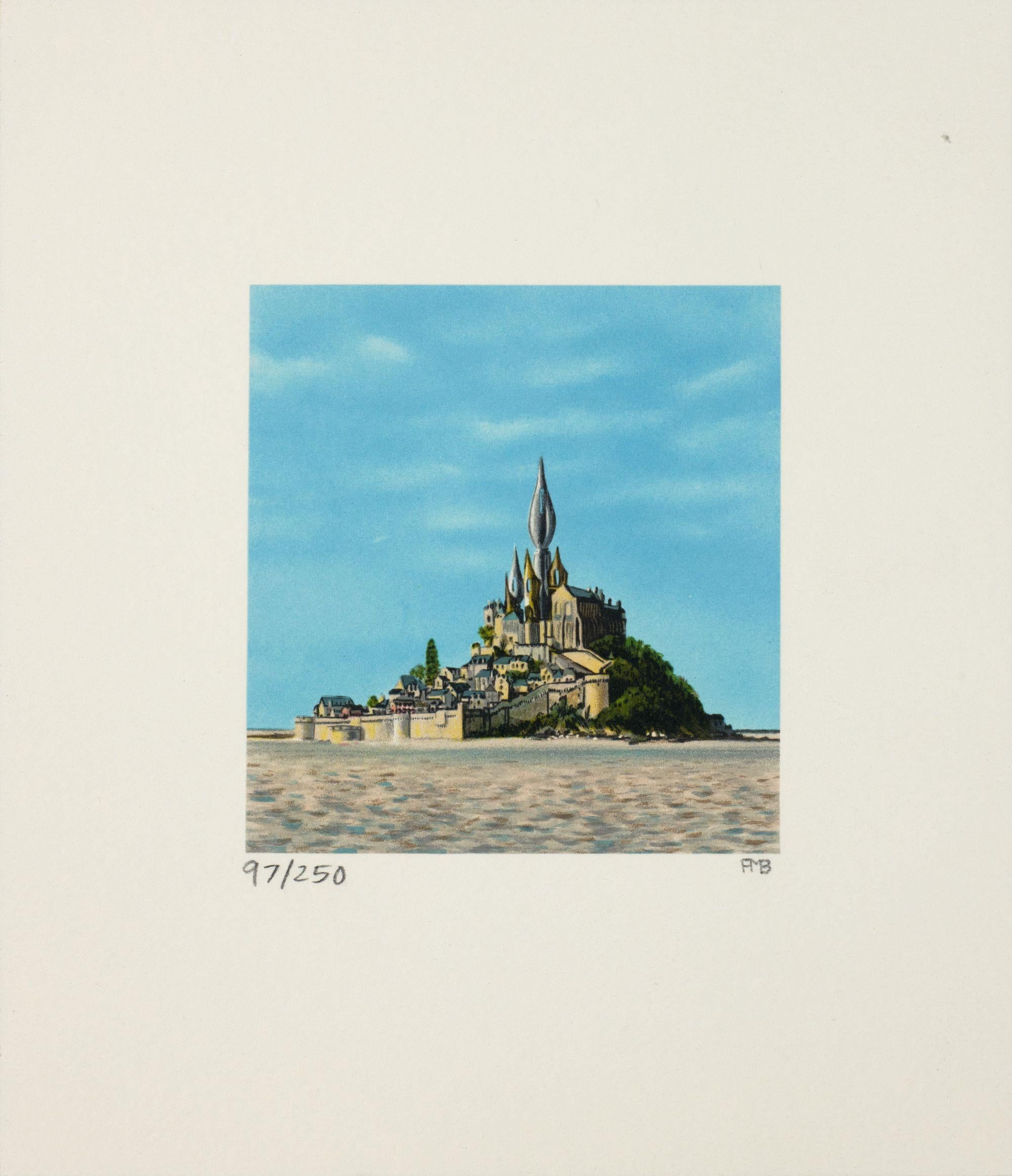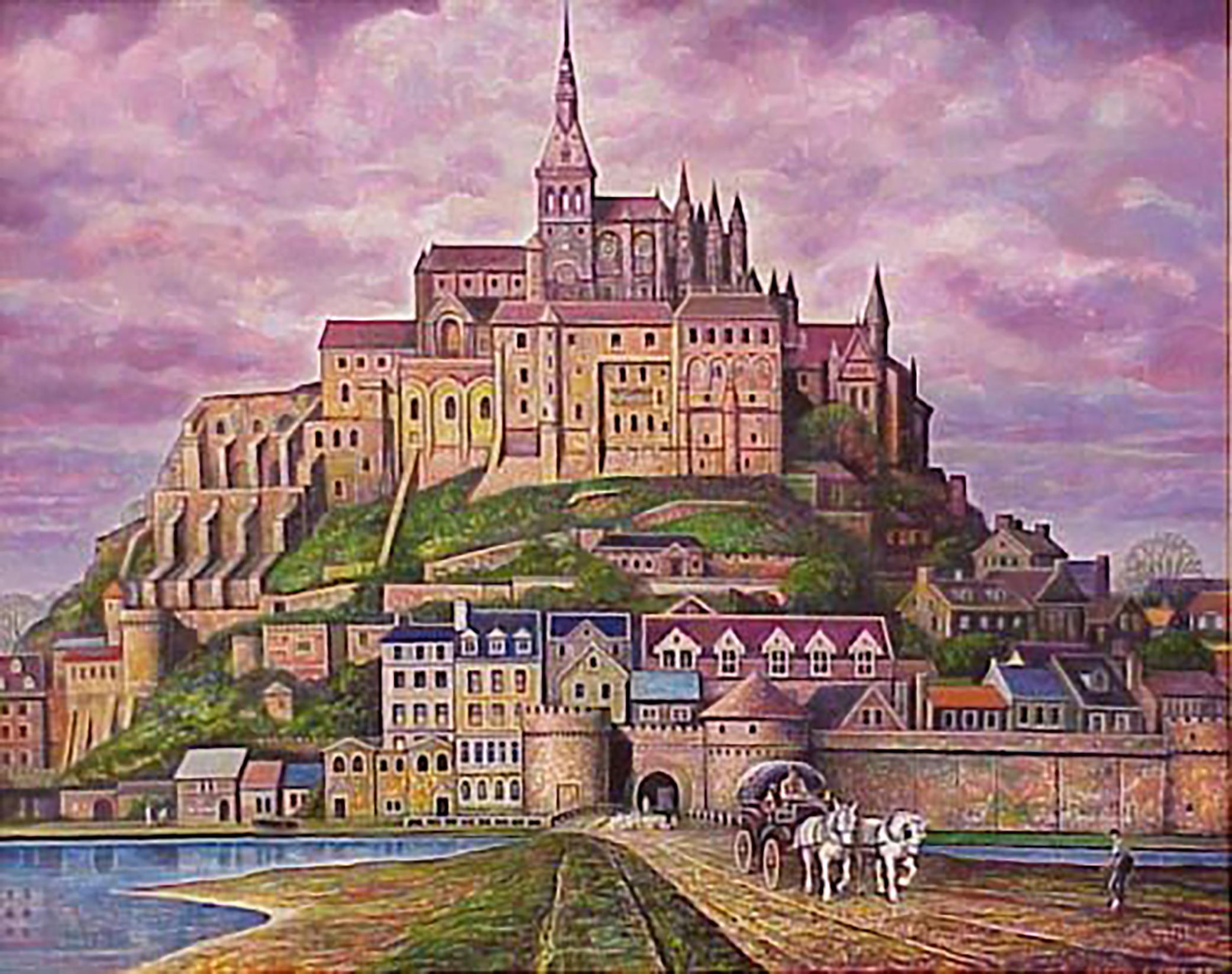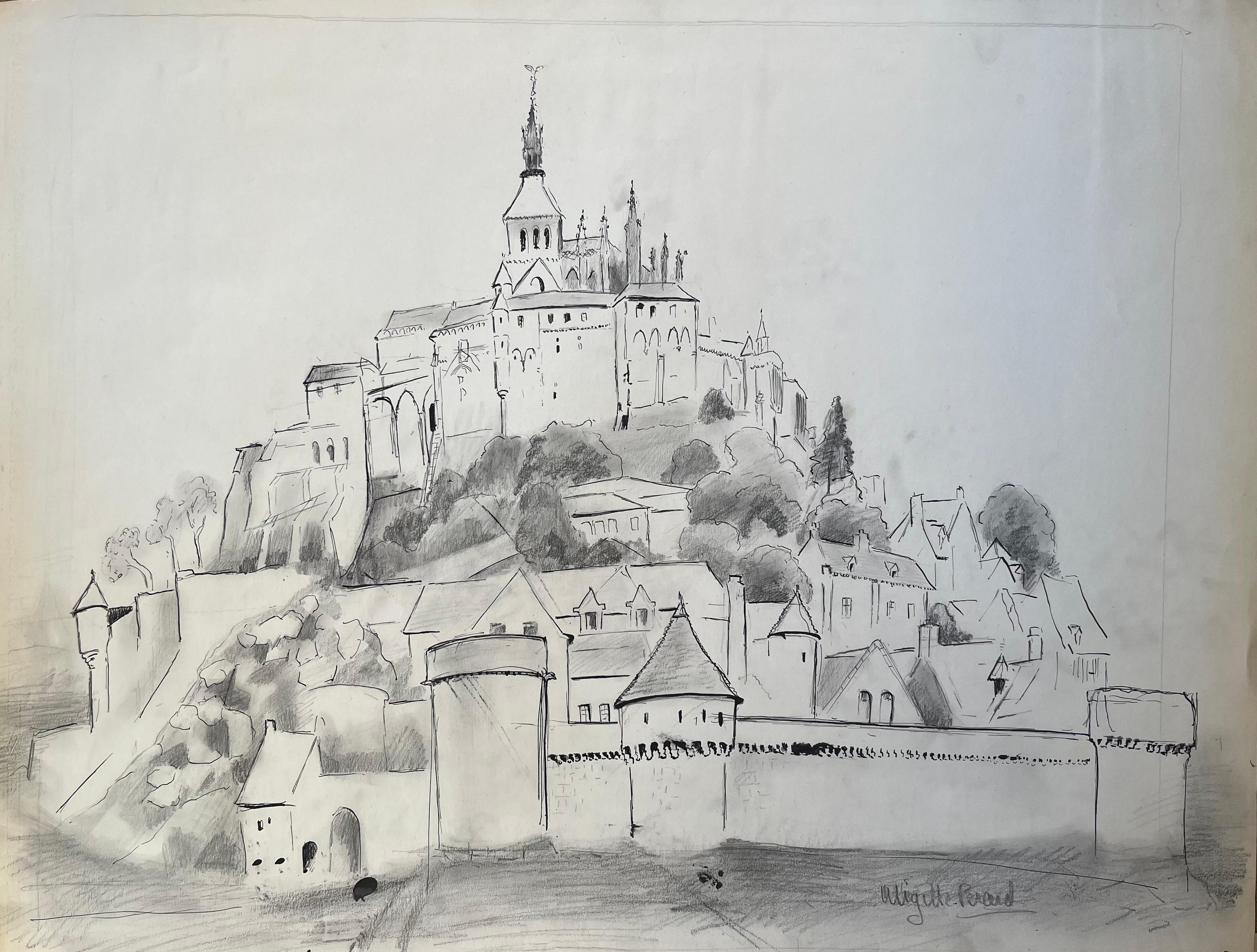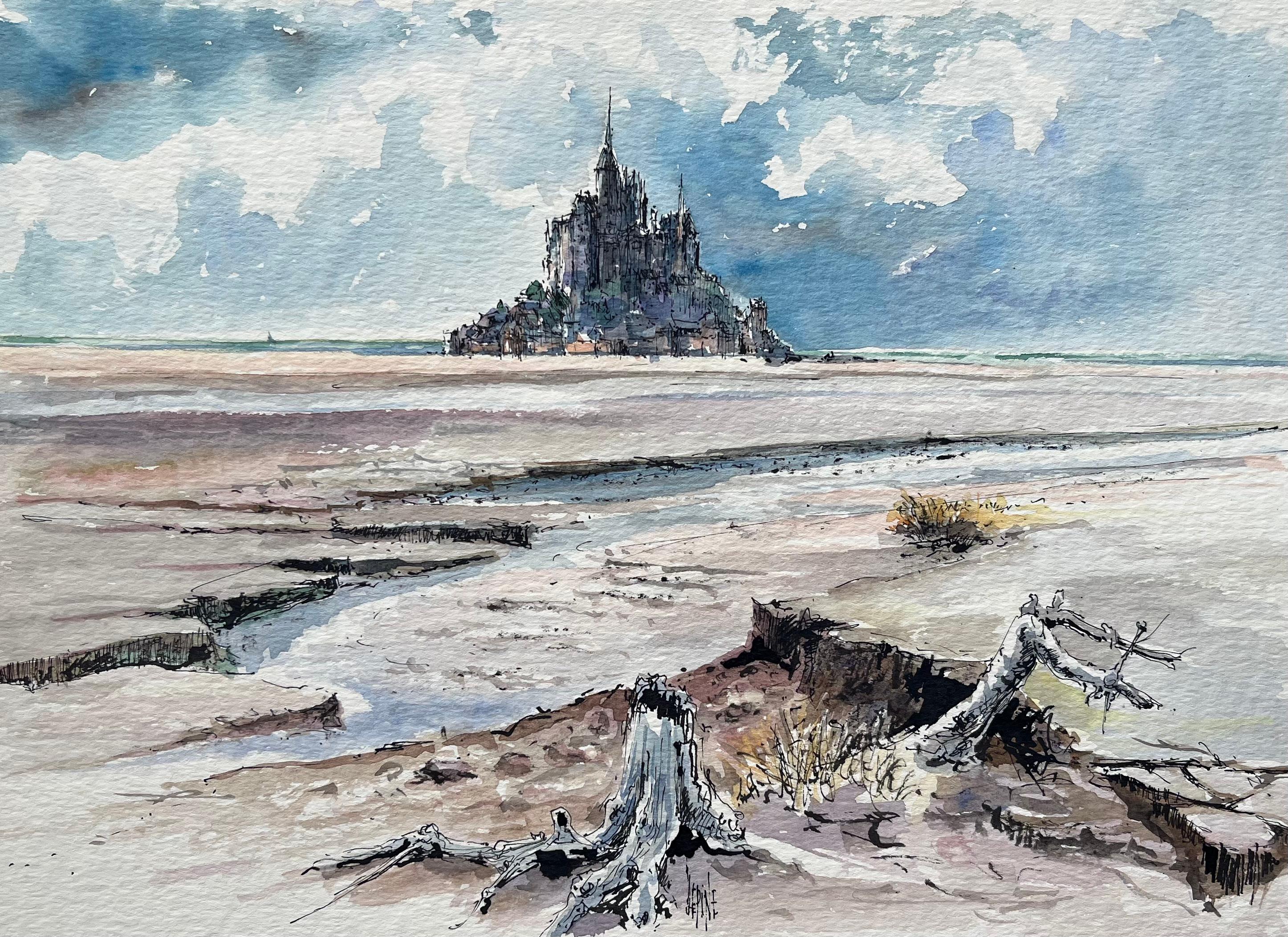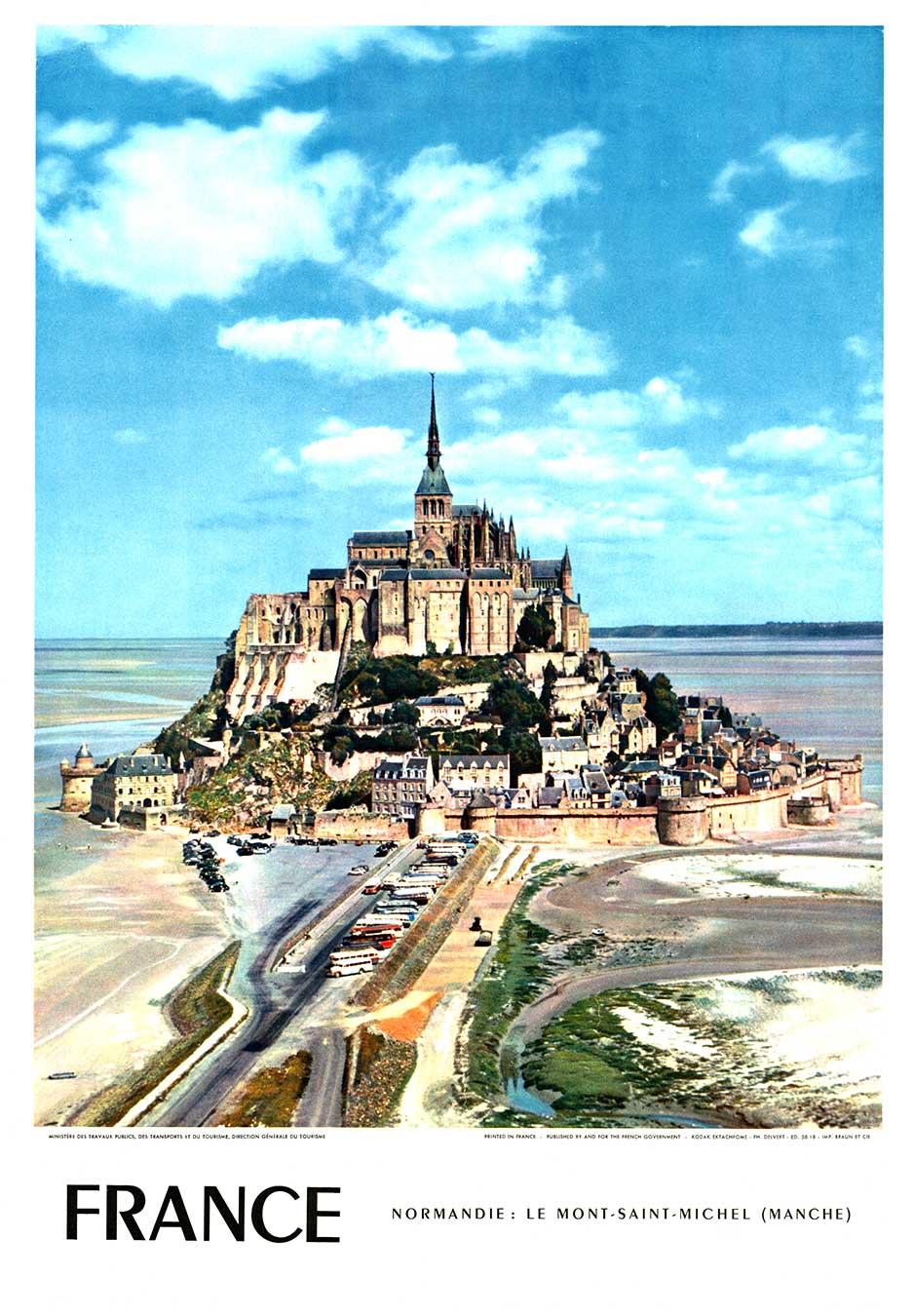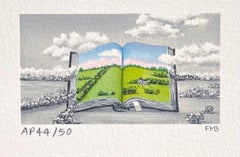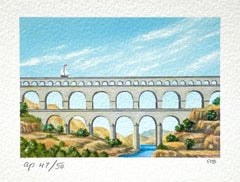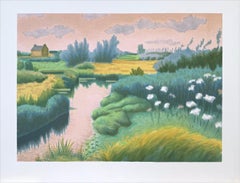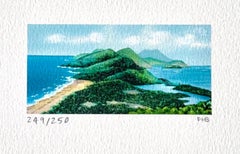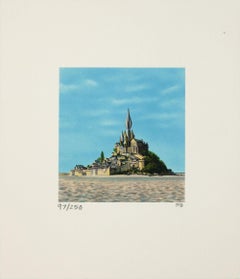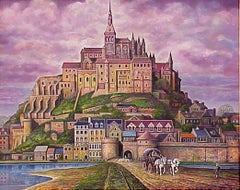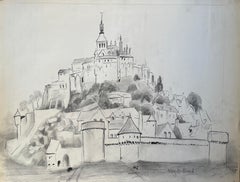Items Similar to MONT SAINT-MICHEL Signed Mini Lithograph, Iconic Landmark Normandy France
Want more images or videos?
Request additional images or videos from the seller
1 of 9
Fanny BrennanMONT SAINT-MICHEL Signed Mini Lithograph, Iconic Landmark Normandy France1992
1992
$400
£305.48
€349.91
CA$570.62
A$621.93
CHF 323.87
MX$7,504.04
NOK 4,071.21
SEK 3,821.92
DKK 2,613.41
About the Item
MONT SAINT-MICHEL is a hand drawn, limited edition lithograph by the American surrealist artist Fanny Brennan, created using traditional hand lithography techniques printed on archival Arches paper, 100% acid-free. MONT SAINT-MICHEL is a realistic miniature landscape scene featuring the iconic landmark, Mont Saint-Michel a tidal island located in the Normandy/Brittany region of France. Brennan's imaginative, humorous style portrays the spires of Mont Saint-Michel's Romanesque church as pen nibs!
Built in the year 700, the Mont-Saint-Michel has stood for centuries in the middle of a bay in the English Channel, and has welcomed Catholic pilgrims since the Middle Ages. Today, this magical tidal island is one of France’s most visited sites, attracting more than three million people every year to visit its abbey and to wander through its beautiful medieval town. The Mont-Saint-Michel and its bay have been a listed UNESCO World Heritage Site since 1979.
Print size - 7 x 6in. unframed, excellent condition, hand-signed and numbered in pencil by Fanny Brennan
Image size - 3 x 3 in.
Edition size - 250
Year published - 1992
Printed at JK FIne Art Editions Co. NJ
About the artist-
Fanny Myers Brennan (1921–July 22, 2001) was a French-American surrealist artist and painter.
Brennan was born in Paris, educated in the United States and Europe and enrolled in an art school in France in 1938. When World War II began, Brennan went to New York. In 1941 the Wakefield Bookshop gallery run by Betty Parsons included her in two shows. She also worked for Harper's Bazaar and the Metropolitan Museum of Art.In 1944, the Office of War Information hired her to work in Europe. Brennan's paintings are typically in miniature format and frequently combine domestic objects such as buttons with landscapes.
- Creator:Fanny Brennan (1921 - 2001, American)
- Creation Year:1992
- Dimensions:Height: 7 in (17.78 cm)Width: 6 in (15.24 cm)
- Medium:
- Movement & Style:
- Period:
- Condition:Mint condition, unframed, pencil signed and numbered by Fanny Brennan, from the master printers private collection.
- Gallery Location:Union City, NJ
- Reference Number:1stDibs: LU832313149512
Fanny Brennan
undefined
About the Seller
4.9
Platinum Seller
Premium sellers with a 4.7+ rating and 24-hour response times
Established in 1975
1stDibs seller since 2018
702 sales on 1stDibs
Typical response time: <1 hour
- ShippingRetrieving quote...Shipping from: Union City, NJ
- Return Policy
Authenticity Guarantee
In the unlikely event there’s an issue with an item’s authenticity, contact us within 1 year for a full refund. DetailsMoney-Back Guarantee
If your item is not as described, is damaged in transit, or does not arrive, contact us within 7 days for a full refund. Details24-Hour Cancellation
You have a 24-hour grace period in which to reconsider your purchase, with no questions asked.Vetted Professional Sellers
Our world-class sellers must adhere to strict standards for service and quality, maintaining the integrity of our listings.Price-Match Guarantee
If you find that a seller listed the same item for a lower price elsewhere, we’ll match it.Trusted Global Delivery
Our best-in-class carrier network provides specialized shipping options worldwide, including custom delivery.More From This Seller
View AllCHATEAU Signed Mini Lithograph, French Countryside, Open Book, Surreal Landscape
By Fanny Brennan
Located in Union City, NJ
CHATEAU is a hand drawn limited edition lithograph by the American surrealist artist Fanny Brennan, created using traditional hand lithography techniques printed on archival Arches p...
Category
1990s Surrealist Landscape Prints
Materials
Lithograph
AQUEDUCT Signed Lithograph, Mini Landscape, Roman Architecture, Sailboat
By Fanny Brennan
Located in Union City, NJ
AQUEDUCT is a hand drawn, limited edition lithograph by the American surrealist artist Fanny Brennan, created using traditional hand lithography techniques printed on archival Arches...
Category
1990s Surrealist Landscape Prints
Materials
Lithograph
BRITTANY LANDSCAPE Hand Drawn Lithograph, Impressionist Style Waterway Scene
By Laurent Marcel Salinas
Located in Union City, NJ
Artist - Laurent Marcel Salinas (born 1913 Alexandria, Egypt, died 2010 in America)
Title - BRITTANY LANDSCAPE
BRITTANY LANDSCAPE is an original hand drawn limited edition lithograp...
Category
1970s Realist Landscape Prints
Materials
Lithograph
HIGH TIDE LOW TIDE Signed Lithograph, Mini Seascape, Islands, Beach, Blue Water
By Fanny Brennan
Located in Union City, NJ
HIGH TIDE, LOW TIDE is a hand drawn, limited edition lithograph by the American surrealist artist Fanny Brennan, created using traditional hand lithography techniques printed on arch...
Category
1990s Surrealist Landscape Prints
Materials
Lithograph
BIG HORN Signed Lithograph, Surreal Mini Landscape, French Horn, Rocky Shore
By Fanny Brennan
Located in Union City, NJ
BIG HORN is a hand drawn limited edition lithograph by the American surrealist artist Fanny Brennan, created using traditional hand lithography techniques printed on archival Arches ...
Category
1990s Surrealist Landscape Prints
Materials
Lithograph
PINK HOUSE Signed Mini Lithograph, French Country-Style Home, Artist Paintbrush
By Fanny Brennan
Located in Union City, NJ
PINK HOUSE is a hand drawn limited edition lithograph by the American surrealist artist Fanny Brennan, created using traditional hand lithography techniques printed on archival Arche...
Category
1990s Surrealist Landscape Prints
Materials
Lithograph
You May Also Like
Mont. St. Michel
By Fanny Brennan
Located in Greenwich, CT
Mont St. Michel is a lithograph on paper with an image size of 3 x 3 inches, initialed 'FMB' lower right and annotated lower left, framed in a contemporary silver and dark gray frame...
Category
20th Century Surrealist Prints and Multiples
Materials
Paper, Lithograph
Mont Saint-Michel, Painting of tidal island in Normandy, France
By Charles Ellis
Located in Fort Washington, PA
Painting of Mont Saint-Michel in Normandy, France
Signed Lower Right
Category
20th Century Landscape Paintings
Materials
Oil, Board
French Mid-Century Drawing of Mont-Saint-Michel with Medieval Ramparts
Located in Cirencester, Gloucestershire
Title: French Mid-Century Drawing of Mont-Saint-Michel with Medieval Ramparts
by Anne Marie Migette Perard (French 1902-1977)
Signed: Yes
Medium: Graphite and Ink on unframed paper
S...
Category
Mid-20th Century Post-Impressionist Landscape Paintings
Materials
Ink, Pencil, Graphite
"Medieval Abby of Mont- St. Michel" Architectural Landscape Edition 4 of 5
By Paul Sprohge
Located in Houston, TX
Green and blue tonal architectural landscape of a cathedral. The work is signed, titled, and dated by the artist. It is framed in a gold frame with a white matte. Paul Sprohge is a H...
Category
1970s Impressionist Abstract Prints
Materials
Lithograph
French Watercolor of a Sunlit Mont Saint-Michel at Low Tide
Located in Cirencester, Gloucestershire
Title: French Watercolor of a Sunlit Mont Saint-Michel at Low Tide
by Robert Lepine (French, 1929 - 2017)
Signed: Yes
Medium: Watercolor painting on artists paper
Size: 11.25 x 13.5 ...
Category
Late 20th Century French School Landscape Drawings and Watercolors
Materials
Watercolor, Pen
Original Normandie: Le Mont-Saint-Michel (Manche) vintage travel poster on linen
Located in Spokane, WA
Original 1958 Normandie Le Mont Saint Michel Travel Poster – Authentic French Vintage Art. Acid-free archival linen backed in Grade A condition, ready to frame.
Step back into the g...
Category
1950s American Realist Landscape Prints
Materials
Offset
More Ways To Browse
Miniature Scene
James Swann
Jules Cavailles On Sale
Lichtenstein Haystack
Lightning Plane
Michael Schofield On Sale
Monet Signed Prints
Palestine Wall Art
Queensboro Bridge
R Marsh
Richard Devonshire
Rowland Langmaid
Sncf Dali
Spring Song Vintage Print
Thomas Moran Etching
Used Porta John
Valerie Thornton
Vintage United Airlines Travel Posters
